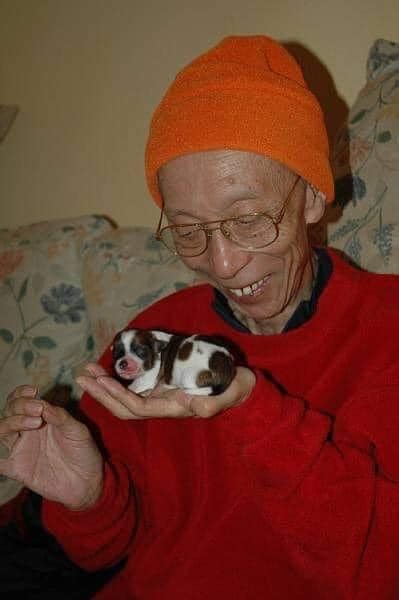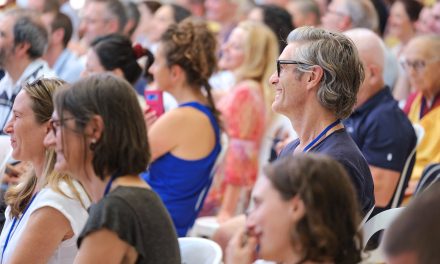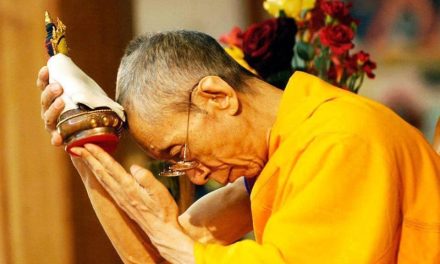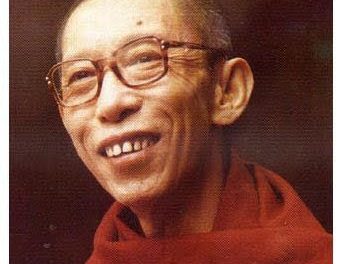“Worship” means “the feeling or expression of reverence and adoration for a deity”. But Ven Geshe Kelsang Gyatso never presented himself as anything other than a simple Buddhist monk. He never asked to be worshipped. Many of his students revere and respect him deeply for his kindness to them, but this is not the same as “worship”.
Some critics of the New Kadampa Tradition (NKT) continue to make claims about the NKT’s supposed cultish devotion toward Geshe Kelsang. However, no evidence is provided for these claims. Geshe Kelsang has never claimed to be an omniscient being or a Buddha. He rarely talked about himself at all. He was a very humble monk and renunciate. He spent many years happily in retreat, only emerging to bring Dharma to the West because his Spiritual Guide Trijang Rinpoche asked him to.
Throughout his life in the West, Geshe Kelsang Gyatso lived modestly and simply in one small room, first for many years at Manjushri Kadampa Meditation Centre where he taught, composed books, and had meetings with his students. Later he moved to Spain where he engaged in more meditation retreat and continued to work tirelessly for his students, writing qualified and acclaimed Dharma books and helping to preserve and promote the Kadampa Buddhism of Je Tsongkhapa in accordance with his own Spiritual Guide’s wishes.
Geshe Kelsang would not typically leave his room except to teach. He possessed very little. He did not own a car, having sold the one car that was offered to him in 1986 so that he could donate the proceeds to Live Aid. He did not own a house, having offered the one he was given for a retreat center in Scotland (Tharpaland). He gave everything that he was offered away, including the royalties on his books and all gifts of money, property, statues, and so on. He never had one single trapping of luxury, power, or worldly success. Nor was he interested in or engaged in politics.
Although he was in good health, in Summer 2009 he voluntarily stepped down as General Spiritual Director of the NKT, in a democratic system of succession that he himself established.
These accusations “worshipping” Geshe Kelsang partly stem from a misunderstanding of Buddha Shakyamuni’s teachings on relying upon a Spiritual Guide. For more on that, see Did Geshe Kelsang Gyatso call himself the Third Buddha or seek veneration from his students?
In keeping with the Kadampa Geshes’ precept “to remain natural while changing your aspiration”, and the commonsense wisdom tradition of Je Tsongkhapa, today’s Kadampa Buddhists are advised to avoid zealous types of behavior that have no place in modern, democratic cultures. One’s view of one’s Spiritual Guide must be kept inside the heart.
As Geshe Kelsang has said:
Teachers should never show ‘I am a holy being, I am Buddha’ and so forth, and also the students should never say, ‘My Teacher is a Buddha’. This is ridiculous. Saying ‘My Teacher is Heruka’ or ‘My Teacher is Vajrayogini’ is not correct conversation! We should speak and act exactly as normal. We should respect what people in society believe. Otherwise, if we behave and react in strange ways that society does not accept, we will become isolated. They will never appreciate us. Even faithful disciples never talk like this. For example, I have many faithful students, but they never say ‘Geshe Kelsang is Heruka’ or ‘He is Buddha’ or ‘He is Lama Tsongkhapa’. They never say this. … Modern people follow the truth as they see it, so if you say ‘He is Heruka’, ‘He is Buddha Shakyamuni’, people will see contradictions and not appreciate or believe you.
Geshe Kelsang has given his students the freedom to develop whatever view they wish of him. They can view him as an ordinary Teacher, or as a kind person, or as a Bodhisattva, or even as a Buddha, as is their wish. But this is their choice and it is a private matter of the heart.






The teaching on the function and necessary qualification of a spiritual guide and how to rely upon him or her correctly is the most precious Buddhist teaching I received from Venerable Geshe Kelsang Gyatso Rinpoche.
If we get it right, it is the means to receive powerful blessings and inspiration for our Dharma practice. Following the lineage coming from Buddha Shakyamuni, the Teacher needs to teach correctly all the objects we need to abandon and the methods to abandon them and teach correctly all the objects to practice and how to practice them, encourage the students and show a good example of this practice.
I feel very, very lucky to have found such a qualified, dedicated and selfless Spiritual Guide in Ven. Geshe-la and also many of his experienced students /Teachers.